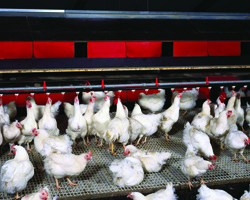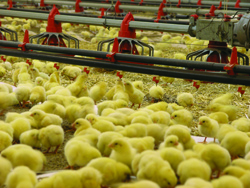
Maintenance Is Key
By Ziggity Systems Inc.
Features Profiles ResearchersWhen was the last time you checked your watering system?
Just as your pickup truck needs regular maintenance, so does the watering system for your broiler operation.
 Just as your pickup truck needs regular maintenance, so does the watering system for your broiler operation. And, just as your pickup has a maintenance schedule, so should your watering system.
Just as your pickup truck needs regular maintenance, so does the watering system for your broiler operation. And, just as your pickup has a maintenance schedule, so should your watering system.
There are certain checks that should be done every day. There are others that require weekly or monthly attention. Described here is a suggested maintenance schedule for a well-run operation.
Daily
Litter: You should walk your poultry houses each day looking at litter conditions. Litter, whether it is caked or dry, will tell you if you have problems with specific drinkers or if your pressure settings are correct. If the litter is wet under one or two drinkers, that is a good indication that the drinkers are leaking and the seat area may need cleaning. If the litter under a majority of the drinkers is caked, your pressure settings may be too high; or the drinkers have simply worn out and need to be replaced.
Meter readings: Keep a daily log of water usage based on your water meter. Any significant variation in water usage can alert you to problems with the birds, such as disease, or the system, such as leaks. Take the meter readings at the same time each day because birds drink at different rates throughout the day. By taking the readings at the same time, you ensure you are not comparing peaks and valleys of water usage.
Drinking angle: Check the angle at which the birds are drinking. New chicks should drink at an angle of about 45 degrees (imagine a line drawn from their feet to their beaks). As the chicks age, you should raise the watering lines so they are drinking at a 50- to 55-degree angle. If the watering line is too low, water will spill onto the litter. Lines too high force the birds to jump to get a drink.
Flush system: Finally, flush your watering system to rid it of sediment and biofilm on a frequent basis. It is recommended to flush more often during hot weather to rid the watering lines of warm water that can encourage the growth of pathogens. Producers can take much of the labour out of flushing lines by installing automatic flushing equipment. Timers can automatically flush the system on a regular basis, and sensors can detect when the water temperature exceeds a certain point, requiring a flush.
 Weekly
Weekly
Water filters: At least once a week, you should check the water filters on the system to determine if they need cleaning or replacing. In some areas, where the groundwater contains high concentrations of substances, such as fine sand or iron, you may have to clean the filters more often than once a week.
Riser tubes: Another check to make is the riser tubes on the enclosed system. The tubes are open at the top and can allow foreign material to enter the watering system. Make sure the tubes are clean and unobstructed.
Water logs: While you have been looking at your water meter logs on a daily basis, it is good to also make a weekly overview. Also, compare the water meter readings with logs from prior flocks, taking into account climate change. This will give you a benchmark against which to judge your flock’s performance. Remember, a water meter records how much water goes into the house, not how much the birds drink. The meter cannot distinguish between water spilled on the floor or consumed by the birds. Any substantial increase or decrease in water usage indicates there is a situation in the poultry house that needs your attention. A large increase in water usage often signals leaking drinkers or lines. A substantial decrease could indicate a disease is causing the birds to not drink as much.
Monthly
System check: Once a month you should check the entire system from wellhead to the end of the drinker lines for any damage or problems. Make sure items like the screen protecting the opening in your header tank is secure and the wellhead cover intact. It’s also a good idea to check the area around the wellhead for potential contaminants. Your well is a direct conduit to the groundwater. If contamination enters the well, it will foul the well water, as well as the groundwater.
Regulators, medicators: Also check the regulators and medicators to make sure they are in good working order. (A note of caution here: producers frequently use buckets to mix stock solutions for medicating their flocks. Make sure any such bucket system has a lid to prevent contaminants from entering the watering system.)
Now is a good time to check the mechanics of your watering system — the items like the timers and the environmental controllers. Make sure these are in good working order and free from debris. Also, check on the water pressure from your well. If the pressure is down, it could indicate a problem with the well.
Once each year, you need to pay a professional to service your well. Unless you have had specific training, this is not a job you should try for yourself. The service should include:
The annual water test to determine bacterial, pH and mineral levels. Your well professional should know what conditions are prevalent in your area and what to test for.
Make sure the well pump is in good working order and at the optimal height within the well casing.
Determine the static flow rate of the well. This will tell you if the well is still performing to specifications or if remediation work is needed.
No matter how often you test your well water, consider testing the water whenever there is a change in the taste or smell or if members of your family are experiencing unexplained illnesses.
None of the procedures described above take much time to complete. By doing them on a regular basis, like the schedule proposed here, you will prevent more serious problems from developing.
Ignoring regular maintenance on your watering system is like ignoring regular maintenance on your pickup truck. Eventually, you will have a breakdown that can result in very expensive repairs.
Print this page